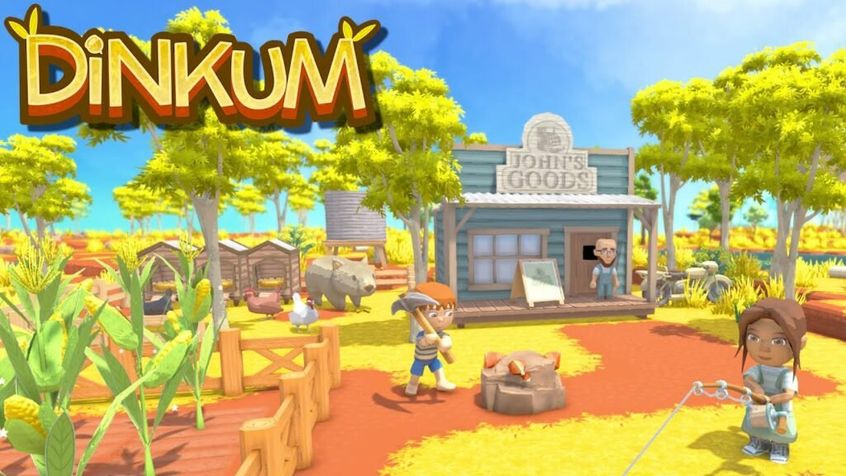Dinkum
Stardew Valley is a masterpiece of game design. Its combination of player agency, freedom of expression, wholesome and engaging narrative, and unfurling world make it fun, pleasantly addictive, and infinitely replayable. It has made its developer buckets of money, and as such, there’s a significant incentive for other games to try to capture some of its magic for themselves. How successful they are and how much of that magic they manage to capture varies. The reality remains, however, that Stardew Valley made it clear that the genre of low-budget town-builders can be very successful, and that the audience is hungry for more. Couple that with the success of crafting games, and you end up with a game like Dinkum.
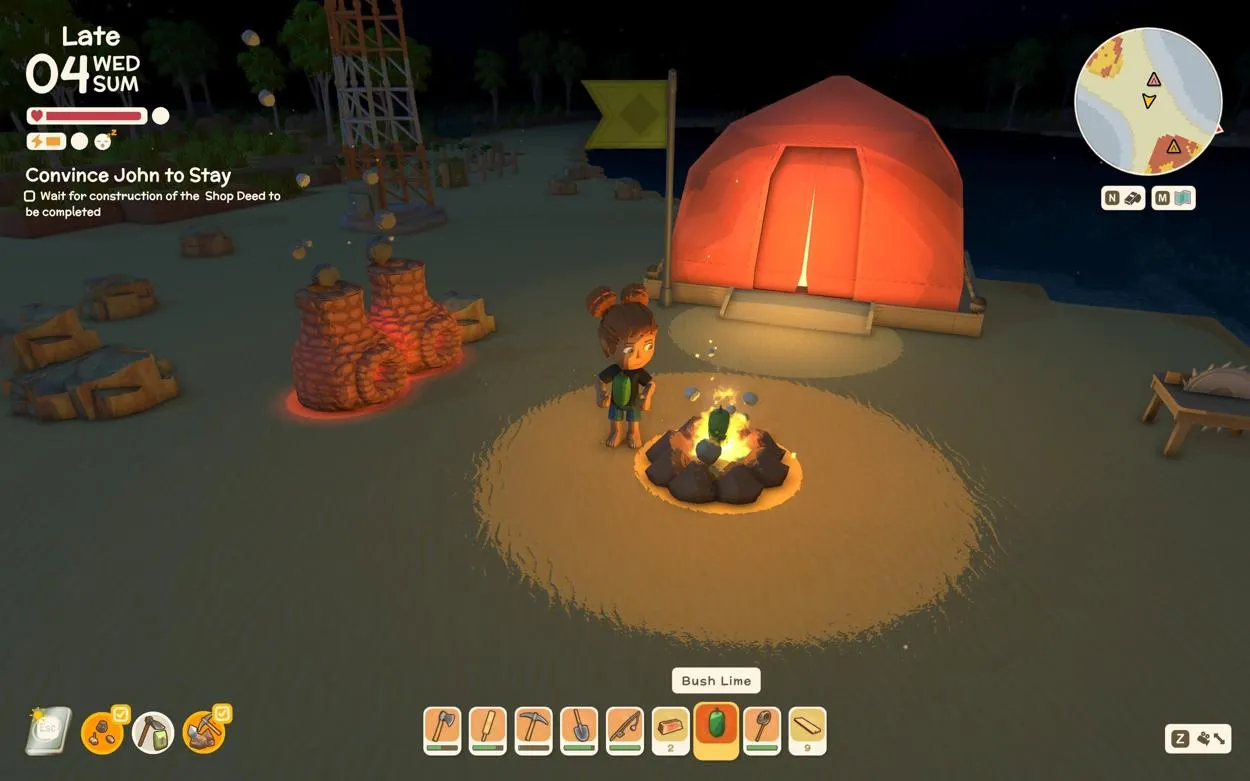 I am alone. I am awake. I have only the fire and this lime now.
I am alone. I am awake. I have only the fire and this lime now.
Dinkum is a crafting simulation game. You play as a character fed up with their urban life who follows the call of an older person to wander off into the wilderness to rebuild a town of their youth through farming, crafting, and befriending a variety of characters.
It sounds familiar, I know. I promise this isn’t Stardew Valley.
Over the course of rebuilding the town, you must learn new skills, such as fishing, mining, crafting, and foraging. Using the resources that are found on your various daily adventures, you can slowly rebuild the town, providing each person with what the need, and turning your barren island into a thriving community.
Look, it’s not Stardew Valley because it’s Australia. It’s thematically in that same vein that’s been resonating with millennials like me about planning and executing the Great Escape to go live on an island or in a cave or in a forest somewhere because that’s easier than dealing with the capitalist urban hellscape we’ve been subjected to, but just because it’s playing with the same themes doesn’t make it the same game however much it may resemble Stardew, and let’s be honest, it is clearly hoping to capitalise -
Let’s start this again, shall we?
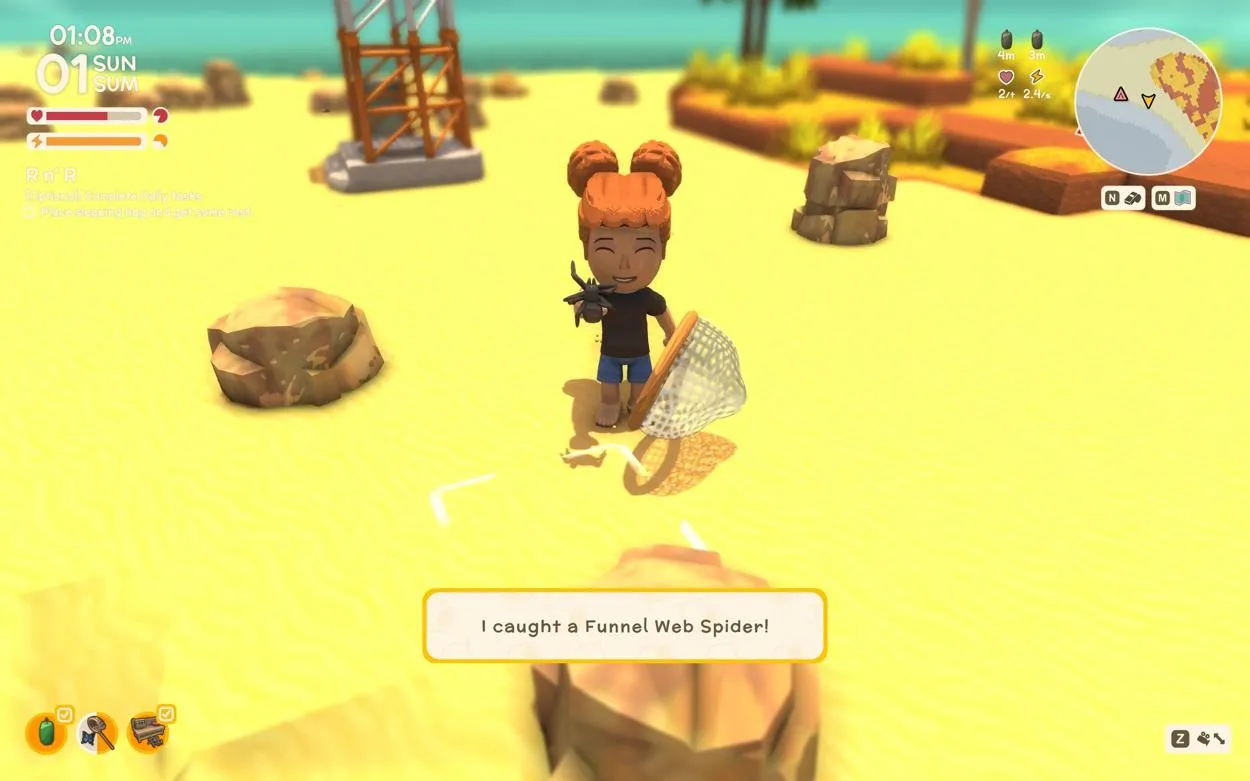 Anyway, that’s how I died on my first day on the island.
Anyway, that’s how I died on my first day on the island.
Dinkum is a crafting simulation game, with a heavy emphasis on crafting. The game focuses on the player rebuilding a town on an island. Doing so requires the harvesting of a variety of resources from all over the island, and the slow accumulation and stacking of those resources to create bigger and better objects. It’s the fairly standard crafting game formula, and it works decently well here. Dinkum provides a range of biomes to explore, resources to collect, and creatures to interact with. These are all based on native Australian counterparts, which I quite enjoyed, giving the game a unique and delightful flavour. In addition to the usual crafting incentives of wanting to gather the resources to make better gear or to complete construction on a building, Dinkum also provides the player with daily quests that they can use to get extra money, reputation, or permit points, which they can then use to upgrade their skills. Everything and every mechanic in Dinkum is a process of slowly building, stacking everything to try and reach some very distant apex.
Dinkum helped me finally put my finger on why I dislike crafting games so much. It’s that grind, that slow build, that reassurance that both the apex and the journey to get there are worth it, when they’re really, really not.
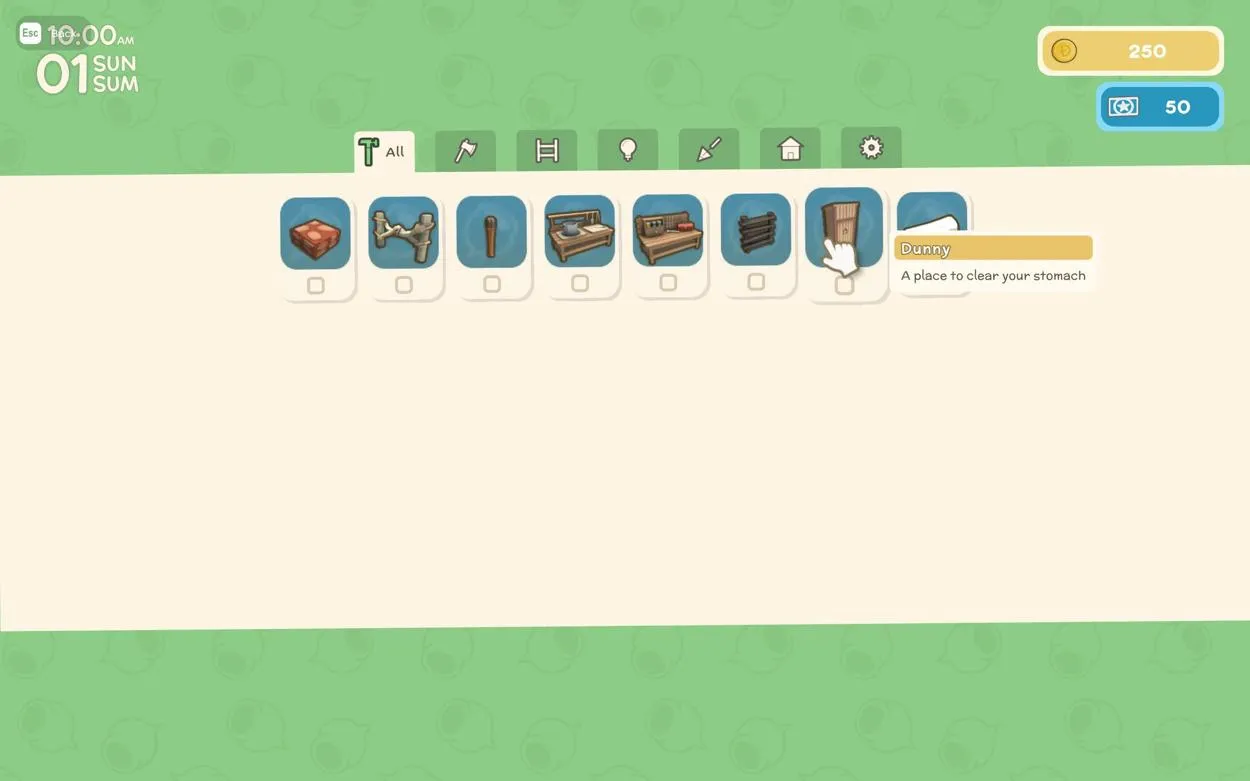 Starting with the important things in life.
Starting with the important things in life.
To understand why Dinkum specifically helped me understand what I dislike about crafting games, it’s helpful to share an example of what the process of adding one building to my town looked like. The premise of Dinkum and all the marketing videos on their Steam page highlight the towns players can build, and the freedom of urban planning players can execute, so it’s worth understanding what it takes to actually get to any of those points.
The first building available to me was a general store, which was great, because my inventory was generally full, and it was nice to be able to sell things. Acquiring the store required first befriending the shop keeper, which took me two days of running errands around the island. These errands were hunting down a specific insect or fish - flies popped up weirdly often - and bringing it to the shopkeeper. Errands complete, the shopkeeper decided to stay, meaning I had to buy a land deed for the shop. Building the shop required planks, nails, and tin. While I could craft the planks and nails, I had to scour the island to find the tin in randomly spawning trash barrels. This took another three days. Tin acquired, the shop began construction, a further two day process. Its completion then placed the town 75000 coins in debt, which would need to be repaid before any other buildings could be built. “Aha!” you might say. “You have a shop, though! You can use that shop to sell things and pay off that debt in no time!” You would be correct about the mechanic for repaying the debt, but be sadly mistaken about its ease. Selling my various bugs and trinkets and shells to the shop netted me a cool 16000 coins per day, meaning I should, in theory, be able to pay off that debt within five days. However, collecting resources to sell requires tools, which degrade and break, and must be purchased to replace. That 16000 coins per day rapidly whittles down to 10000, taking tool replacement into consideration, and assuming all I’m doing is focusing on making money. I was not focused on making money, as the aforementioned inventory size limited how much I could collect to sell, instead splitting my time being money and crafting progression. After fifteen days, I was no less in debt, with no real ability to progress anything until that debt was paid.
My character fled her capitalist dystopian hellscape only to end up captured by another. Sixteen tonnes, and what do I get? Another day older and deeper in debt.
 /sobs in student loans
/sobs in student loans
Dinkum being a grinding game is, of course, by design. Crafting games as a genre generally require some degree of grinding, be it through repeating an action or rummaging through the same spawn points day after day. The problem with Dinkum is that the grind is the game. As much as it touts the town building and what can actually be crafted with the various resources, those crafted objects do very little to mitigate the grind, just change it. Once I craft animal traps and higher value objects, that doesn’t change the debt cycle and need to scour the island for a rare resource that I can’t progress without. It just refocuses and recolours it. Gaining reputation with the various villagers and doing quests doesn’t give any extra depth to them or your relationship to them, instead just granting an item. The process of building a town is a prolonged one, even by the standards of crafting games, and becomes a tedious game of repetition with no real reward but those the player concocts for themselves.
And then, the game itself will fight against the player’s self-set goals using the mechanics themselves.
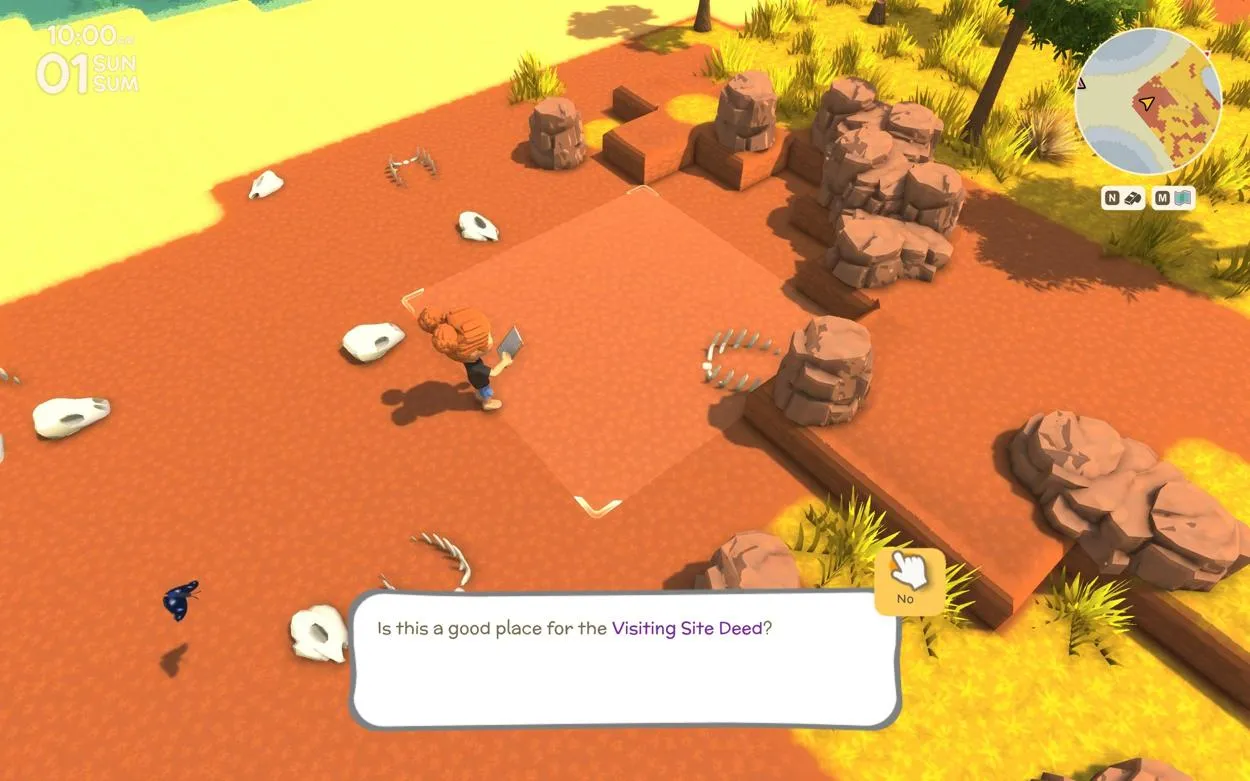 I wouldn’t want my visitors to get the wrong impression of this island, so the boneyard is perfect.
I wouldn’t want my visitors to get the wrong impression of this island, so the boneyard is perfect.
Dinkum uses a 3D model approach to its game design, which is fine in theory, until coupled with its system of having interactions take place in a square grid section, ostensibly in front of where the character is facing, but realistically, in some random place somewhere near the character’s face. Having an interaction spot be a square isn’t an issue until coupled with a camera that doesn’t always accurately display where the character is looking, and which can provide a misleading perspective on what the character is about to interact with. This means, for example, that the camera and my character’s body suggest a butterfly is in my interaction square. However, when I actually use my bug net, it turns out I’m nowhere near the butterfly, and have wasted one of my bug net’s uses. As a one-off, this is easy to laugh off as my little character being a klutz. When it happens again and again, it makes the grind inherent to the game that much more annoying.
Coupled with that is both the unintuitiveness of some controls with the over-accessibility of others. Left clicking is the default control for taking an action with whatever the character has equipped. Planting seeds, then, intuitively ought to involve left clicking to dig a hole with a shovel, equipping a seed, left clicking to plant it, and left clicking to bury it again. Instead, the player needs to use q - a button not used for anything else in the game - to plant a seed, with the game giving no indication or ability to remap this button. It’s a baffling design choice that illustrates the general obnoxiousness of doing most things in the game. There are either far too many steps for what needs to be a streamlined activity, unintuitive steps, or a general inability to focus interaction on what the player is actually trying to interact with. For all the tedium of the grind mechanics, it’s the addition of clunky interactions and poor control design that finally made me recognise not only why I dislike crafting games in general, but Dinkum in particular.
I’m not interested in battling camera angles and controls to collect one of a hundred identical objects in an inventory too small to accommodate them. It’s just not fun, and there are better uses of my time.
 WELCOME TO FORT DINGO
WELCOME TO FORT DINGO
There’s an undeniable charm to Dinkum. It’s dedication to its Australian identity is delightful, and the idea of forging a new community on an island far away from the horrors of the world is always a wonderful one. Everything about how Dinkum executes on that idea, though, highlights how much good gameplay is needed to sell a good idea. The very design of Dinkum is a slog, and I had to immediately leave its charm behind.
Youtube: /reviews
